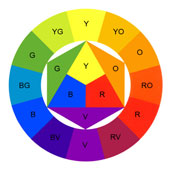Introduction:
A visual artist is a general term used for any person interested in the visual studies. Such a person may be a painter, a potter, graphic designer, sculptor or a product designer.
This course has been developed for a person interested in understanding the various aspects of Colour and its application in Visual Design. The goals of this course is to sensitize the sculptor /artist /designer to the art of visual observation of colour in ones surroundings, enhancing ones imagination, learning to conceptualize and create and enhancing ones skills in representation and communications of ideas through play of form and space using colour .
It encourages learning by doing. It encourages analysis and discussions on the work done.
Aims:
Colour is one of the important elements of visual design. An understanding of aspects of the science and psychological of colour on human senses is important for one to appreciate the application of colour in visual design.
This course will help you to enhance your understanding of the different aspects of Colour Theory and its different design application in Product Design and Interiors.
Course Contents:
This course involve reading material, audio-visual presentations and studio assignments that introduces colour as a visual design element; and in understanding underlying concepts and principles of their compositions for visual appeal.
1. Introduction
2. The Science of Colour
3. Colour Perception and Human Responses
4. Colour Description and Colour Theories
5. Colour Interaction and Colour Effects
6. Colour in Design Principles
7. Use of Colours in Products and Packaging Design
8. Use of Colours in Interior Design

Kolkata Flower Market: Flowers present a wide variety of colours. Quite often the names of the flowers such as ‘rose’ red or ‘sunflower’ yellow are used to explain colours. Some colours such as violet also take their names from the flowers. (Image source: Shruti Hemani, 2009)
Reading Material / Texts:
1. J. Bowers, Introduction to Two-Dimensional Design: Understanding Form and function, John Wiley & Sons,1999.
2. L. Holtzschue, Understanding Colour: An Introduction for Designers, 2nd Edition, John Wiley and Sons, 2002.
3. W. Wong, Principles of Two Dimensional Design, John Wiley and Sons, 1972.
4. J. Itten, The Art of Colour, New York, VNR, 1973.
5. T. W. Knight, Transformations in Design: a formal approach to stylistic change and innovation in visual arts, Cambridge Univ. Press, 1998.
6. J. Bairstow, R. Barber, M. Kenny, Design Modelling - Visualising Ideas in 2 Dimension and 3 Dimension, Hodder and Stoughton, 2005.
7. H.G Greet and R. Kostellow, Elements of Design and the Structure of Visual Relationships, Architectural Press, New York, 2002.

